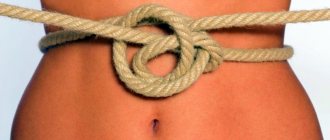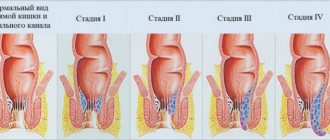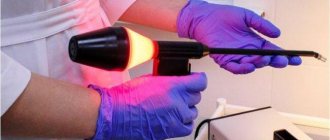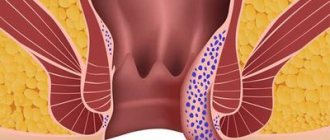Home » Hemorrhoids » Hemorrhoids after childbirth: treatment
Sign up for a consultation with a proctologist for the treatment of hemorrhoids for 3,500 rubles and receive a treatment prescription within 30 minutes for 1 appointment
Find out what day you need to make an appointment to get a consultation without a queue.
Experience 44 years 73 operations per month 876 operations per year 171 reviews Author of 73 scientific papers Has 9 patents 6,818 requests per month
Call
Almost every second woman develops hemorrhoids after childbirth. When pushing, intra-abdominal pressure increases, anal fissures appear, and bleeding from the anus opens. As a rule, proctological disease appears in women who have given birth naturally.
This proctological disease can be acute or chronic. You should not delay visiting a doctor or self-medicate, as the disease may worsen and lead to negative consequences.
Hemorrhoids: symptoms in women after childbirth
In the early stages, postpartum hemorrhoids are asymptomatic. The woman does not feel pain or discomfort and leads her usual lifestyle. However, hemorrhoids develop rapidly, the nodes increase in size.
The following symptoms of proctological disease in women are distinguished:
- inflammation of hemorrhoids;
The size of hemorrhoids increases after labor. They become inflamed, swollen, and take on a bluish tint. The pain intensifies during the act of defecation. With chronic hemorrhoids, pain is constantly present and does not disappear even after taking medications.
- pain syndrome;
A woman feels severe nagging pain in the anus while moving. The pain also intensifies when coughing or sneezing.
- elevated temperature;
In most cases, hemorrhoids are accompanied by an inflammatory process of the mucous membrane, so the woman’s temperature rises to 37.5 degrees.
- bleeding from the anus;
In the early stages, bleeding is rare. The blood comes out by drip. In critical cases, the bleeding does not stop at all and is a stream.
- problems with bowel movements;
Constipation and gastrointestinal disorders are the most popular symptoms that worry a patient after childbirth. Flatulence is observed after eating, colicky pain in the intestines and bloating appear. Impurities of blood, pus, and mucus appear in the stool. This symptom indicates the development of an infection and requires immediate attention from a medical professional.
- lack of appetite;
With hemorrhoids, women often have a lack of appetite, nausea and vomiting for no apparent reason. Accordingly, the patient rapidly loses weight, becomes exhausted, tired and inactive.
- prolapse of hemorrhoids;
As the size of hemorrhoids grows, they begin to fall out of the anus. In the first and second stages, the lumps can be returned back to the anus. However, in advanced cases, you cannot do without the help of a specialist.
- itching and burning in the anus;
The patient is concerned about itching and burning in the anus, which usually appear in the presence of infection. Symptoms intensify with movement and interfere with the usual way of life.
If any symptom appears, you should immediately make an appointment with a proctologist. The disease progresses and affects internal organs.
Dosage of the drug
Suppositories are administered rectally, 1 piece twice every 24 hours. Treatment continues until severe symptoms disappear. After the end of the acute phase, the dosage of the drug is reduced, then the patient administers 1 suppository once a day.
Before use, remove the suppository from the package and sprinkle with water. The patient lies on his side, presses his legs to his stomach and inserts a suppository. After this manipulation you need to lie down for 15 - 20 minutes. Before introducing suppositories, the anus is cleaned with cool boiled water. During therapy, you need to maintain anal hygiene, eat right to prevent constipation and improve bowel movements.
The ointment is used to create applications. About 1 g of cream is squeezed onto a sterile gauze pad and applied to the external hemorrhoids. The procedure is carried out twice a day (necessarily before bedtime). Before applying gauze to the affected area, empty your bowels and clean the anorectal area with cool water without soap.
In addition, the cream is used rectally. Then they put a nozzle on the tube, insert it into the anus and squeeze out a little ointment. When the acute symptoms disappear, use the product once a day (before going to bed).
Reasons for the development of hemorrhoids in pregnant women and after childbirth
The appearance of hemorrhoids is explained by some reasons that could lead to pathology. Among them:
| Intensive fetal growth | 1. During pregnancy, the work of all internal organs is disrupted, as the fetus is constantly growing and strong pressure is generated. |
| Changes in the hormonal levels of a pregnant woman | 1. From the first trimester of pregnancy, a woman’s hormonal levels change. There is an excessive release of the hormone progesterone. Progesterone impairs the elasticity of blood vessels and negatively affects blood flow in the veins. 2. In the third trimester of pregnancy, the level of the hormone relaxin increases. The cervix relaxes immediately before childbirth, and the elasticity and firmness of the vascular walls decreases. A woman’s body weight increases, which contributes to the appearance of hemorrhoids. Blood cannot circulate normally, which causes blood clots to form. |
| Labor activity | 1. During pushing and natural childbirth, the vessels of the rectum are deformed. The outflow of blood from the cavernous veins worsens. The cavernous plexuses fill with excessive amounts of blood. 2. Often hemorrhoids fall out of the anus during labor. |
| Poor nutrition | 1. The cause of the development of hemorrhoids during pregnancy can be a disrupted diet. The lack of vitamins and minerals and foods containing fiber leads to slower intestinal motility. 2. Constipation and other gastrointestinal disorders are provoked. Feces stagnate in the intestines, which increases the pressure of the vascular walls. Hemorrhoids are damaged during the act of defecation. |
| Excessive exercise | 1. Intense physical activity is extremely dangerous during pregnancy. They can not only lead to the threat of miscarriage, but also negatively affect the functioning of the esophagus. Intra-abdominal pressure rapidly increases, which affects blood flow in the pelvic vessels. |
| Overweight woman | 1. During pregnancy and after childbirth, women gain weight in most cases. This process is explained by the fact that there is excessive secretion of prolactin, or, in other words, hypothalamic syndrome. It develops due to labor pushing with the help of oxytocin. Obesity is the main reason why hemorrhoids and other proctological diseases develop. 2. Hemorrhoidal vessels are overloaded due to excessive body weight. The volume of circulating blood increases. |
| Women's sedentary lifestyle | 1. An inactive lifestyle during pregnancy is extremely dangerous. As a rule, the attending physician always advises the patient to spend more time outdoors. In addition, the time spent should be active. However, not everyone follows the doctor's recommendations. 2. With a sedentary lifestyle, intra-abdominal pressure increases, anal fissures appear, acute hemorrhoids progress, which enters the chronic stage. |
Reduced immunity can also affect the development of hemorrhoids During pregnancy, a woman’s body is overloaded, so it’s worth consuming more vitamins and minerals.
Causes of pathology in nursing mothers
Hemorrhoidal disease and lactation (breastfeeding) are in no way related to each other. The reasons that provoke the formation of hemorrhoids are inherited by the young mother from pregnancy and childbirth.
If delivery occurs naturally, then extremely high intra-abdominal pressure during contractions and pushing blocks the outflow of venous blood, including from the cavities located in the rectum, around the anus. The longer the labor, the higher the risk of hemorrhoids.
An additional factor affecting the blood vessels is the pressure of the head when the baby passes through the birth canal, which provokes stretching of the walls of hemorrhoidal cones and the production of biologically active substances in the walls of the cavities - kinins - the root cause of inflammation. Kinins stimulate the relaxation of the anal sphincters, which, simultaneously with the dilation of the cervix, causes prolapse of the nodes. Midwives sometimes adjust them with their hands to prevent pinching.
Dyspepsia
After delivery, the restoration of the status quo is helped by the hormone oxytocin, which contracts the uterus, simultaneously pulling the hemorrhoidal cones to their original place. But very often the predisposition to hemorrhoids persists, since insufficient oxytocin is synthesized, the smooth muscles of the intestine remain relaxed under the residual effect of the pregnancy hormone - progesterone. This situation reduces peristalsis and causes constipation.
Hemorrhoids during breastfeeding cause difficulty defecating
, which can continue for another month after birth, until oxytocin and estrogens begin to prevail over progesterone. The pelvic floor muscles can additionally be strengthened by gymnastics. Doctors believe that at least two years must pass before the second birth for the woman’s body to fully recover.
Diarrhea contributes to the occurrence of hemorrhoids in nursing mothers
, which irritates the intestines, causes a rush of blood to the varicose caverns, and the veins of the anorectal area do not provide normal outflow.
Lifestyle and physical activity
During lactation, a woman does more than just care for her baby. The young mother returns to her household duties, and she is subject to additional physical stress: carrying a child in her arms, cleaning, cooking, a stroller, a crib, bags for a walk and a visit to the doctor - all this causes an increase in intra-abdominal pressure with weak pelvic floor muscles.
There is stagnation in the caverns, an increase in hemorrhoids. A little physical activity stimulates constipation and the growth of hemorrhoids. The problem is aggravated by improper, unbalanced, disordered nutrition of the woman in labor.
Genetics
We must not forget about hereditary predisposition, which cannot be corrected; it should simply be taken into account: insufficiency of the muscles and ligaments of the rectum, loss of elasticity of the vessels, normal fixation of the internal nodes with their sagging.
Provoking factors
Typically, all signs of hemorrhoids with hepatitis B appear within a couple of weeks, which is directly related to the number of risk factors. The more there are, the higher the likelihood of pathology of the rectal veins during lactation, but two or three are enough. In addition to the above, they stimulate hemorrhoidal disease:
- stress;
- infection;
- anal sex.
Thus, the occurrence and progression of hemorrhoids in nursing mothers are based on two mechanisms: venous insufficiency and weakening of the muscular-ligamentous apparatus in the rectal cavity.
Hemorrhoids after childbirth: how to treat
Most patients are interested in how to treat hemorrhoids after childbirth for a nursing mother. Of course, the treatment method is individual for each patient. Treatment depends on the condition, the size of the hemorrhoids, and the presence of concomitant diseases.
Treatment of hemorrhoids after childbirth, treatment during breastfeeding should be gentle and as safe as possible, so as not to harm the health of the newborn and the woman herself. To cure proctological pathology as soon as possible, it is worth starting therapy when the first symptoms appear. Only then will the risk of complications be reduced to zero, and the pain will disappear in a matter of days.
Treatment is carried out in three ways. Among them:
- conservative treatment;
- minimally invasive treatment;
- surgical intervention.
In most cases, hemorrhoids after childbirth are treated with medications so as not to harm the baby. This method is effective and non-traumatic. Hemorrhoidal cones are removed only if necessary in advanced stages, when the nodes begin to fall out of the anus after each act of defecation. They use drugs of both local and systemic action.
Reviews
Katya: After giving birth, the doctor said that if you don’t want the knots to come out, you can’t push in the toilet. He prescribed me glycerin suppositories and Natalsid. Natalsid in the morning and at night so that the nodes do not bleed, and glycerin suppositories - before you want to “big”. Within a week after giving birth, I was able to straighten the knots.
Olga: I had terrible pain after giving birth, huge hemorrhoids came out. Walking hurts, going to the toilet hurts. My mother-in-law recommended belladonna suppositories; she inserted the first one and felt a burning sensation. Then I consulted with my doctor and prescribed me Relief Advance. The baby was breastfed, my treatment did not affect him, and I felt better about the 4th day.
Lena: Like most people, after giving birth I had hemorrhoids and bloody stools. I washed myself with cold water and put on Procto-glivenol suppositories. It became easier after about a month. Either the medicine worked or it was time. Throughout the entire time, I breastfed the child and tried to maintain the diet so that there would be no constipation. In general, the main thing is patience and systematic treatment.
Treatment with ointments and suppositories
When treating hemorrhoids, ointments and suppositories are often used, which act directly on the source of the disease and eliminate the cause of inflammation.
- troxevasin;
Nursing mothers who suffer from external hemorrhoids are prescribed this drug. This ointment is made on the basis of Troxerutin, a natural rutin. The drug has a positive effect on blood circulation in the vessels of the anus, normalizes intra-abdominal pressure, and makes the vessels more resistant and strong. In addition, the risk of thrombosis and other complications is reduced. The size of the buds decreases with regular use.
- Heparin-based drugs;
Pregnant and lactating women are also prescribed Heparin ointment. This drug helps thin the blood and increase blood flow in the cavernous plexuses. The blood vessels are strengthened, the formation of blood clots is prevented, swelling and inflammation disappear. The risk of relapse is reduced to zero.
- Bezornil;
To get rid of pain and itching in the anus, women are prescribed a drug called Bezornil. This ointment consists of natural ingredients that are safe even during the lactation period. The drug has an analgesic and anti-inflammatory effect, kills harmful bacteria.
- Vishnevsky ointment;
The ointment, which consists of birch tar, castor oil and xeroform, also has an antiseptic effect.
- Posterisan;
It is an effective and safe drug during the lactation period. Produced in the form of rectal suppositories and gel. Effective for both external and internal hemorrhoids. Using Posterizan you can treat damaged areas. To relieve inflammation, pregnant and lactating women are prescribed suppositories based on sea buckthorn oil. Itching and burning in the anus are eliminated, dead soft tissue is regenerated.
Before starting a course of treatment, you should consult with your doctor.
List of approved drugs for hemorrhoids during lactation for oral administration
The principles of hemorrhoid therapy are based on a diverse effect on provoking factors:
- choosing the optimal diet, a balanced diet that is beneficial for mother and baby;
- dosed distribution of physical activity;
- regular hygiene measures in the intimate area;
- with conservative therapy, selecting safe medications for the baby while improving the general condition of the mother;
- if surgical intervention is necessary, consultation with a proctologist about the advisability of a particular treatment method;
- use of background folk therapy on the recommendation of a doctor;
- prevention of relapse of hemorrhoidal disease.
Treatment of external or internal hemorrhoids during lactation, with a reasonable approach, is not dangerous for mother and baby, and is not a reason to delay the start of therapy. The progression of the disease is dangerous due to the development of an emergency situation, hospitalization in a hospital, separation from the child for a long period, and forced transfer to artificial nutrition.
Conservative therapy for postpartum hemorrhoids consists of systemic medications taken orally and external medications with local, local action.
Treatment of hemorrhoids during breastfeeding is limited by the requirements for the composition of medications: the medicine should not enter the blood, milk, or the child’s body, so as not to cause allergies or digestive disorders. And if this happens, then its negative impact on the baby should tend to zero. Therefore, there is no place for untested remedies in a comprehensive treatment regimen. Usually, when taken orally, doctors focus on two groups of drugs: venotonics and laxatives.
Venotonics
Venotonics (phlebotonics) – stimulate the tone of the veins, the valve apparatus of the capillaries of the rectum, and exhibit angioprotective properties. Treatment of hemorrhoids during lactation with venotonics is an integral part of complex treatment at all stages of the disease (even at the advanced, last stage - without them, preparation for surgery and rehabilitation is impossible).
Safe for babies are tablets based on flavonoids - diosmin, hesperidin, their synthetic analogue - rutin and natural, plant-based venotonics.
Detralex
Detralex tablets. The best and most popular systemic remedy for hemorrhoids is a complex of bioflavonoids, which have a powerful venotonic effect.
Vasocket
Vasoket tablets. The product has angioprotective, vascular wall restoration, and anti-inflammatory properties.
Venarus
Venarus tablets. The domestic synthetic analogue of Detralex has angioprotective properties.
Phlebodia 600
Phlebodia 600 capsules are an integral part of the complex treatment of hemorrhoidal disease and are responsible for the vascular tonic effect.
Troxevasin
Troxevasin tablets. Venotonic with angioprotective properties based on rutin. A good antioxidant that reduces inflammation.
Troxerutin
Troxerutin capsules. Phlebotonic and angioprotector, has P-vitamin activity, from the rutin group.
Askorutin
Ascorutin tablets. An inexpensive drug, a powerful antioxidant, restores vitamin C and P deficiency, and exhibits angioprotective properties. A derivative of the drug - Ascorutin D for diabetics, contains food sorbitol instead of sugar.
Normoven
Normoven tablets. A dietary supplement based on rutin combined with natural ingredients is a source of vitamin C, normalizes venous outflow, and increases the tone of the veins. Available to residents of Ukraine.
Chemoroidin
Hemoroidin tablets. A dietary supplement with inulin, a natural prebiotic that stimulates the growth of bifidobacteria, which improves intestinal function, exhibits a venotonic effect in the treatment of hemorrhoids, without side effects.
Laxatives
Laxatives for hemorrhoids are necessary to normalize the digestion process, prevent constipation, and soften fecal stones that can injure the mucous membrane. Lactulose-based drugs are considered the safest; they are allowed during breastfeeding. Senna is prohibited in all forms, as it is addictive.
Forlax
Forlax powder.
A representative of the group of osmotic laxatives for the preparation of a solution, which is taken orally, stimulates intestinal motility, while beneficial vitamins and microelements are not lost from it, and the water-electrolyte balance in the body is not affected. Fortrans has a similar effect.
Duphalac
Duphalac syrup.
Changes the flora of the colon (lactobacillus), which increases acidity and stimulates peristalsis. At the same time, the volume increases and the stool softens, which causes a laxative effect. Portalac, Normaze, Normolakt have a similar effect.
Drug therapy
In the initial stages of hemorrhoids, women are prescribed Troxevasin in tablet form. The drug does not have a negative effect on the baby’s health; the components of the drug practically do not pass into breast milk.
During the lactation period, homeopathic medicines are also prescribed for the treatment of proctological diseases. Hemorrhoids are treated with venotonic drugs. Among them are Venza, Venoruton and others. If bleeding from the anus is profuse, then Ascorutin, which contains vitamin C, is effective.
To normalize intestinal function and improve microflora, you should take laxatives. This group of medications softens stool and prevents stool from stagnating in the intestines. Defecation will not be so painful, the hemorrhage will disappear.
Diet features
It is quite difficult to completely cure hemorrhoids after childbirth. The disease is characterized by an undulating course, in which periods of remission are replaced by relapses. With the help of proper drug therapy and a healthy diet, it is possible to prevent exacerbation and extend the period of calm for a long time.
Diet is an integral component of the treatment of hemorrhoids among all groups of patients
Nutritional guidelines to reduce hemorrhoid symptoms while breastfeeding:
- exclusion from the diet of fortifying and gas-forming products;
- the majority of the diet should be porridge, except rice and semolina;
- if a young mother is prone to constipation, she should include prunes, dried apricots, beets, fermented milk products, oatmeal, and buckwheat porridge in her menu;
- It is recommended to avoid strong coffee, carbonated drinks, white bread, sweet confectionery, and alcohol;
- To prevent complications of hemorrhoids, you should drink more water.
Important! Following a diet in the early stages of the disease helps prevent further development of the pathology and get rid of the symptoms of the disease.
Surgery and minimally invasive procedures
In the third and fourth stages of hemorrhoids, surgery and minimally invasive procedures are used, since medications are ineffective. When breastfeeding, gentle procedures are carried out that relieve the woman of hemorrhoids and at the same time do not harm the baby.
One of the most popular treatment methods is called cryotherapy. Hemorrhoidal neoplasms are treated with liquid nitrogen. Necrosis of soft tissue occurs under the influence of low temperatures. After a few days, the tumors disappear.
An effective way to treat pathology is latex ligation using rings. During the procedure, a surgical instrument, a ligator, is used. A latex ring is placed at the base of the hemorrhoid. Blood does not enter the node, necrosis occurs, the node dies and disappears.
The procedures are carried out in the private proctology center “Proctologist 81”.
Dental treatment
Some young mothers are afraid to go for dental treatment because they read somewhere that anesthesia can have a bad effect on the quality of breast milk. In reality, this is not so: the doctor gives a local injection, which has a short-term effect and is quickly eliminated from the body, and therefore does not cause any harm to the baby’s health? As stated in the online magazine “Doctor Zubov”. So it is possible and necessary to treat teeth with pain relief during lactation. It is better to clarify in advance which drug will be administered to you, and inform the dentist about breastfeeding. In this case, the doctor will select the optimal remedy that will not only provide excellent pain relief during dental treatment, but will also be eliminated from the body as quickly as possible.
Traditional methods of treating hemorrhoids
Traditional methods of treatment are popular. To relieve swelling and pain in a short time, use potato suppositories. This product is known for its anti-inflammatory properties. The potatoes are washed and peeled. Suppositories are cut into small lengths and inserted into the anus after bowel movement.
To stop the inflammatory process and get rid of itching and burning, it is recommended to make baths with medicinal herbs. For this, chamomile flowers, yarrow grass, walnut branches and other components are used. The ingredients are poured with two liters of warm water. The broth is infused, after which it is filtered. The anus area is immersed in warm liquid. When the temperature decreases, the procedure should be completed.
An alternative to yarrow is hop cones, which also have anti-inflammatory properties. For hemorrhoids, dogwood berries are used, which relieve swelling and have an antibacterial effect. Dogwood berries are taken orally before each meal.
special instructions
The cream should not be used if you are allergic to any of the components. This restriction applies to expectant mothers up to the 13th week of pregnancy, as well as patients with liver dysfunction. In addition, this dosage form is contraindicated in children.
The drug does not have a sedative effect, so it is used before work related to concentration and reaction speed. There is no information about overdose with ointment. If she accidentally got inside, then you need to go to the hospital. In this case, the doctor should rinse the stomach and prescribe enterosorbents.
Sometimes the dosage form provokes negative phenomena:
- skin rash;
- nettle fever;
- contact dermatitis;
- neuratic edema;
- cardiac dysfunction;
- bronchospasm.
When the drug gets on the inner membranes, burning and itching occurs. If adverse reactions occur, you should stop using the ointment and consult a doctor. The use of rectal suppositories is contraindicated if you are allergic to the substances in the composition. In addition, the drug is contraindicated in expectant mothers under 13 weeks and in patients with functional liver disorders.
The decision to prescribe medication is made by the doctor after examination. If there is no positive dynamics with regular use, you should visit a doctor. In this case, it is necessary to clarify the diagnosis and adjust the therapeutic course.
Sometimes after using suppositories the following negative phenomena appear:
- Quincke's edema, facial swelling, cardiac dysfunction, bronchospasm;
- skin rash, itching, burning, nettle fever. The danger with these symptoms is that they can spread;
- burning, pain in the anus, increased intestinal motility.
If the dosage is increased or the drug is accidentally swallowed, you should go to the hospital. During lactation, Procto-Glivenol is not contraindicated, the main thing is to follow the rules of use.
Candles "Anuzol": composition, description
The drug "Anuzol" is produced in the form of rectal suppositories. Each suppository contains xeroform in an amount of 100 mg, belladonna extract 20 mg and zinc sulfate 50 mg. The additional components are: glycerin, emulsifier, solid fat and polysorbate. Each suppository weighs no more than 2.31 g. Suppositories are packaged in plastic blisters - 10 suppositories in 1 package.
You can store the drug in the refrigerator or in another cool place with a temperature of no more than 15 degrees Celsius. It is necessary to exclude the penetration of direct sunlight, and also limit the access of children. If these rules are followed, the product can be stored within the general shelf life, which is 2 years from the date of production.









